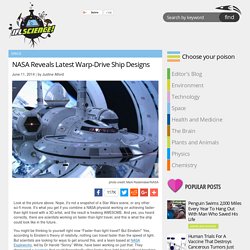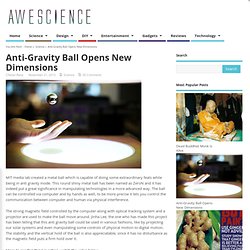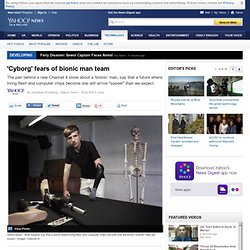

17 GIFs To Prove Technology Has Gone Too Far. 1.

This zipper design that won’t let you down I didn’t think that science and technology have gone so far. But after watching these stunning technology and science achievements I’m 100% convinced that we are living in a world where nothing is impossible. So don’t wait and just check out 17 mind-blowing technology gifs that are shouting loudly that future is here. 2. 3. 4. 5. 6. NASA Reveals Latest Warp-Drive Ship Designs. Look at the picture above.

Nope, it’s not a snapshot of a Star Wars scene, or any other sci-fi movie. It’s what you get if you combine a NASA physicist working on achieving faster-than-light travel with a 3D artist, and the result is freaking AWESOME. And yes, you heard correctly, there are scientists working on faster-than-light travel, and this is what the ship could look like in the future. You might be thinking to yourself right now “Faster-than-light travel? But Einstein!” If a spaceship could be designed in such a way that it created a warp bubble, then the space in front of the ship would be compressed and the space behind would expand. “Remember, nothing locally exceeds the speed of light, but space can expand and contract at any speed,” White told io9. So of course, White’s new design incorporates these ideas and involves “a sleek ship nestled at the center of two enormous rings, which create the warp bubble,” 3D artist Mark Rademaker explained to io9.
Turing Test breakthrough as super-computer becomes first to convince us it's human - Gadgets and Tech - Life & Style. Computing pioneer Alan Turing said that a computer could be understood to be thinking if it passed the test, which requires that a computer dupes 30 per cent of human interrogators in five-minute text conversations.

Eugene Goostman, a computer programme made by a team based in Russia, succeeded in a test conducted at the Royal Society in London. It convinced 33 per cent of the judges that it was human, said academics at the University of Reading, which organised the test. It is thought to be the first computer to pass the iconic test. Though there have claims other programmes have successes, those included set topics or question in advance.
A version of the computer programme, which was created in 2001, is hosted online for anyone talk to. Japanese firm plans 250 mile-wide solar panel belt around Moon. Anti-Gravity Ball Opens New Dimensions - Awescience.com. MIT media lab created a metal ball which is capable of doing some extraordinary feats while being in anti gravity mode.

This round shiny metal ball has been named as ZeroN and it has indeed put a great significance in manipulating technologies in a more advanced way. The ball can be controlled via computer and by hands as well, to be more precise it lets you control the communication between computer and human via physical interference. The strong magnetic field controlled by the computer along with optical tracking system and a projector are used to make the ball move around. Jinha Lee, the one who has made this project has been telling that this anti gravity ball could be used in various fashions, like by projecting our solar systems and even manipulating some controls of physical motion to digital motion.
The stability and the vertical hold of the ball is also appreciatable, since it has no disturbance as the magnetic field puts a firm hold over it. How NASA might build its very first warp drive. 'Cyborg' fears of bionic man team. The two experts behind a new Channel 4 show about a 'bionic' man admit they were spooked by some of what they saw - including cyborgs made by the U.S.

Army. One presenter was perturbed by experiments where chips were inserted in the brains of living rats, to 'enhance' their memory. The U.S. military's hi-tech research wing DARPA is developing humanoid robots which 'look like The Terminator', says the programme's robot expert. United States gravity control propulsion research. American interest in "gravity control propulsion research" intensified during the early 1950s.

Literature from that period used the terms anti-gravity, anti-gravitation, baricentric, counterbary, electrogravitics (eGrav), G-projects, gravitics, gravity control, and gravity propulsion.[1][2] Their publicized goals were to develop and discover technologies and theories for the manipulation of gravity or gravity-like fields for propulsion.[3] Although general relativity theory appeared to prohibit anti-gravity propulsion, several programs were funded to develop it through gravitation research from 1955 to 1974.
Evidence of existence[edit] Mainstream newspapers, popular magazines, technical journals, and declassified papers reported the existence of the gravity control propulsion research. For example, the title of the March 1956 Aero Digest article about the intensified interest was "Anti-gravity Booming. " A. Histories[edit] Contemporaneous literature[edit] Gravity Research Foundation[edit] Visualizing video at the speed of light — one trillion frames per second. Mobzilaa.com - Tech news,apps,gadgets,iphone,ipad.